The Martyrdom of Saint Lawrence may refer to:
- The Martyrdom of Saint Lawrence (Titian), a painting of 1558 by Titian
- The Martyrdom of Saint Lawrence (Bernini), a sculpture of 1617 by Gian Lorenzo Bernini
The Martyrdom of Saint Lawrence may refer to:

The Galleria Borghese is an art gallery in Rome, Italy, housed in the former Villa Borghese Pinciana. At the outset, the gallery building was integrated with its gardens, but nowadays the Villa Borghese gardens are considered a separate tourist attraction. The Galleria Borghese houses a substantial part of the Borghese Collection of paintings, sculpture and antiquities, begun by Cardinal Scipione Borghese, the nephew of Pope Paul V. The building was constructed by the architect Flaminio Ponzio, developing sketches by Scipione Borghese himself, who used it as a villa suburbana, a country villa at the edge of Rome.

The Chiesa di San Giacomo dall'Orio is a church located in the sestiere (quarter) of Santa Croce in Venice, northern Italy.

The Church of Saint Andrew on the Quirinal is a Roman Catholic titular church in Rome, Italy, built for the Jesuit seminary on the Quirinal Hill.

The Ecstasy of Saint Teresa is a sculptural group in white marble set in an elevated aedicule in the Cornaro Chapel of the church of Santa Maria della Vittoria in Rome. It was designed and completed by Gian Lorenzo Bernini, the leading sculptor of his day, who also designed the setting of the Chapel in marble, stucco and paint. It is generally considered to be one of the sculptural masterpieces of the High Roman Baroque. The sculpture depicts Teresa of Ávila, a Spanish Carmelite nun and saint, swooning in a state of religious ecstasy, while an angel holding a spear stands over her.
Ercole Ferrata was an Italian sculptor of the Roman Baroque.

Sant'Agnese in Agone is a 17th-century Baroque church in Rome, Italy. It faces onto the Piazza Navona, one of the main urban spaces in the historic centre of the city and the site where the Early Christian Saint Agnes was martyred in the ancient Stadium of Domitian. Construction began in 1652 under the architects Girolamo Rainaldi and his son Carlo Rainaldi. After numerous quarrels, the other main architect involved was Francesco Borromini.

The Martyrdom of Saint Matthew is a painting by the Italian master Michelangelo Merisi da Caravaggio. It is located in the Contarelli Chapel of the church of the French congregation San Luigi dei Francesi in Rome, where it hangs opposite The Calling of Saint Matthew and beside the altarpiece The Inspiration of Saint Matthew, both by Caravaggio. It was the first of the three to be installed in the chapel, in July 1600.
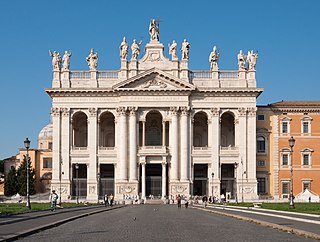
The Italian Catholic Church, or Catholic Church in Italy, is part of the worldwide Catholic Church in communion with the Pope in Rome, under the Conference of Italian Bishops. The pope serves also as Primate of Italy and Bishop of Rome. In addition to Italy, two other sovereign nations are included in Italian-based dioceses: San Marino and the Vatican City. There are 225 dioceses in the Catholic Church in Italy, see further in this article and in the article List of Catholic dioceses in Italy.
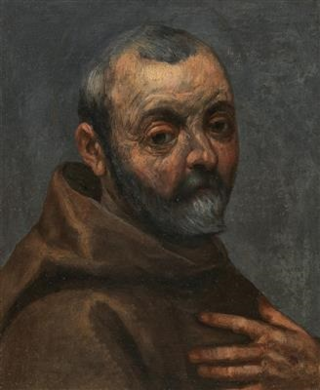
Iacopo Negretti, best known as Jacopo or Giacomo Palma il Giovane or simply Palma Giovane, was an Italian painter from Venice and a notable exponent of the Venetian school.

The Borghese Collection is a collection of Roman sculptures, old masters and modern art collected by the Roman Borghese family, especially Cardinal Scipione Borghese, from the 17th century on. It includes major collections of Caravaggio, Raphael, and Titian, and of ancient Roman art. Cardinal Scipione Borghese also bought widely from leading painters and sculptors of his time, and Scipione Borghese's commissions include two portrait busts by Gian Lorenzo Bernini. Most of the collection remains intact and on display at the Galleria Borghese, although a significant sale of classical sculpture was made under duress to the Louvre in 1807.
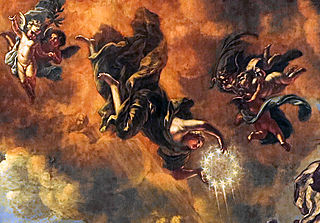
The Crown of Immortality is a literary and religious metaphor traditionally represented in art first as a laurel wreath and later as a symbolic circle of stars. The Crown appears in a number of Baroque iconographic and allegoric works of art to indicate the wearer's immortality.
Events from the year 1617 in art.

The Crucifixion is a life sized painting by the Venetian artist Titian, completed in 1558 and presently hanging in the sanctuary of the church of San Domenico, Ancona. Jesus Christ is shown crucified, with Saint Mary and Saint John standing either side of the cross in the Stabat Mater tradition. The kneeling figure is of Saint Dominic. The canvas was completed during Titian's fifth decade of painting, and is one of the works marking a shift toward his extensive exploration of tragedy and human suffering.
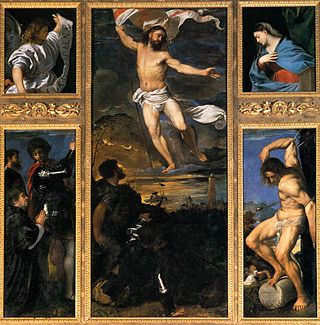
The Averoldi Polyptych, also known as the Averoldi Altarpiece, is a painting by the Italian Renaissance painter Titian, dating to 1520–1522, in the basilica church of Santi Nazaro e Celso in Brescia, northern Italy.
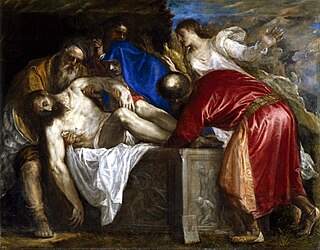
The Entombment is a 1559 oil-on-canvas painting by the Venetian painter Titian, commissioned by Philip II of Spain. It depicts the burial of Jesus in a stone sarcophagus, which is decorated with depictions of Cain and Abel and the binding of Isaac. The painting measures 137 cm × 175 cm and is now in the Museo del Prado in Madrid. Titian made several other paintings depicting the same subject, including a similar version of 1572 given as a gift to Antonio Pérez and now also in the Prado, and an earlier version of c.1520 made for the Duke of Mantua and now in the Louvre.

The Martyrdom of Saint Lawrence is an early sculpture by the Italian artist Gian Lorenzo Bernini. It shows the saint at the moment of his martyrdom, being burnt alive on a gridiron. According to Bernini's biographer, Filippo Baldinucci, the sculpture was completed when Bernini was 15 years old, implying that it was finished in the year 1614. Other historians have dated the sculpture between 1615 and 1618. A date of 1617 seems most likely. It is less than life-size in dimensions, measuring 108 by 66 cm.

The Martyrdom of Saint Lawrence is a 1558 painting by Titian, now in the church of I Gesuiti in Venice. It so impressed Philip II of Spain that he commissioned a second version in 1567 for the basilica at El Escorial.
The Martyrdom of St Sebastian may refer to:
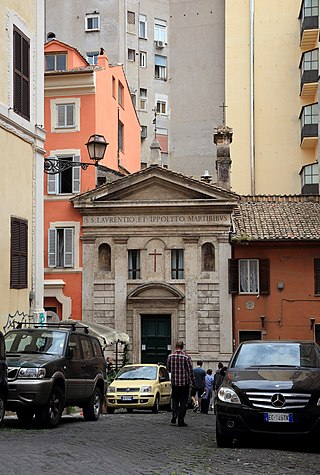
Santi Ippolito e Lorenzo in Fonte, better known as San Lorenzo in Fonte, is a Catholic church in Rome (Italy), Rione Monti, on Via Urbana.

The Martyrdom of Saint Peter Martyr is a 1526-1528 oil on panel painting by Palma Vecchio, now in the Museo d'arte sacra San Martino in Alzano Lombardo.